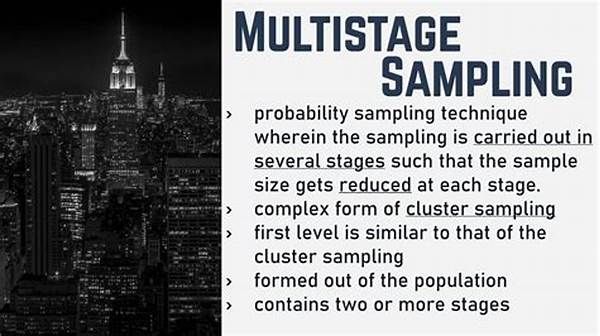In the realm of research methodologies, the concept of multistage sampling holds a distinguished place owing to its systematic and hierarchical approach. It enables researchers to manage large populations by breaking them down into more manageable subsets, thus ensuring the process is both efficient and cost-effective. Multistage sampling in research is particularly beneficial when dealing with geographically dispersed populations, as it involves selecting samples in stages, often using different types of sampling methods at each stage. This multi-layered strategy enhances the precision of data collection and contributes to the reliability of research findings.
Read Now : Adaptive Strategies For Changing Climates
Overview of Multistage Sampling in Research
Multistage sampling in research is a nuanced approach that involves two or more stages of sampling. Initially, researchers might engage in cluster sampling to divide the larger population into clusters. Once clusters are determined, subsequent stages might involve simple random sampling or systematic sampling to select participants within each cluster. The flexibility inherent in multistage sampling makes it a popular choice across various fields, particularly when resources are constrained.
Essentially, multistage sampling embodies the principles of effective sampling design. It allows researchers to address logistical challenges and optimize resource allocation. By layering different sampling techniques, researchers can enhance the representativeness of samples and improve the accuracy of their analysis. As such, multistage sampling is not merely a technique but a strategic decision that aligns with the objectives of nuanced research inquiries.
Advantages of Multistage Sampling in Research
1. Cost Efficiency: Multistage sampling in research lowers costs by focusing on selected clusters rather than an entire population upfront.
2. Manageability: By breaking down larger populations, multistage sampling facilitates more manageable data collection efforts.
3. Flexibility: Researchers can blend different sampling methods, enhancing the adaptability of multistage sampling in research to diverse research scenarios.
4. Precision: Each stage of sampling fine-tunes the selection process, enhancing the precision of multistage sampling in research.
5. Comprehensive Reach: This methodology allows for a greater geographic reach as researchers can efficiently sample across dispersed areas through multistage sampling.
Challenges and Considerations for Multistage Sampling in Research
While multistage sampling in research offers numerous advantages, it is not without its challenges. Researchers must carefully design each stage to prevent bias that might occur due to improper sample selection. Missteps in one stage could propagate errors throughout subsequent stages, potentially compromising the validity of research outcomes. Ensuring methodological rigor is paramount to harness the full potential of multistage sampling.
Furthermore, the complexity involved in multistage sampling necessitates a thorough understanding of various sampling techniques. Researchers must be adept at choosing appropriate methods at each stage and should remain vigilant about potential sources of error. These considerations underline the necessity for comprehensive planning and a well-thought-out approach to multistage sampling in research, safeguarding against the pitfalls that could undermine the integrity of the research.
Key Factors Influencing Multistage Sampling in Research
Methodological Rigor in Multistage Sampling
1. Stage Planning: Designing clear stages is crucial for effective multistage sampling in research.
2. Technique Selection: Appropriate selection of sampling techniques at each stage impacts outcomes.
3. Bias Prevention: Striving to eliminate bias is essential within multistage sampling in research.
4. Error Monitoring: Continuous evaluation of potential errors maintains research integrity.
Read Now : International Education System Benchmarking
5. Resource Allocation: Efficient distribution of resources across stages supports the sampling process.
6. Training: Ensuring field researchers are adequately trained enhances the precision of multistage sampling in research.
7. Technological Support: Utilization of modern tools aids in managing and analyzing data efficiently.
8. Ethical Considerations: Adhering to ethical guidelines is imperative in multistage sampling.
9. Representation Accuracy: Ensuring the sample accurately represents the population under study is pivotal.
10. Evaluation and Feedback: Constant feedback loops can optimize the sampling process.
Conclusion and Future Implications of Multistage Sampling in Research
Multistage sampling in research continues to evolve as a versatile and indispensable strategy for tackling the challenges inherent in empirical inquiry. Its adaptiveness allows researchers to tailor sample selection processes according to specific research needs, providing a robust framework for data collection across diverse fields. As research challenges grow increasingly complex, the need for efficient, reliable sampling methods becomes even more critical.
Future implications of multistage sampling point towards greater integration with technology to streamline processes, enhance data accuracy, and mitigate the limitations of current methodologies. By leveraging innovations in data management and analytical tools, researchers can further refine their sampling strategies, ensuring potent, evidence-based findings. Multistage sampling thus stands as a testament to the ongoing advancement in research methodologies, aligning with the aspirations for more precise, inclusive, and comprehensive data analysis.
Summary of Multistage Sampling in Research
Multistage sampling in research is a sophisticated and strategically layered approach to sample selection, allowing researchers to address logistical constraints while maintaining high levels of precision and accuracy. By dividing overall populations into clusters and selectively sampling these groups, this method achieves greater efficiency and resource management. The intricacies of multistage sampling afford flexibility, enabling researchers to blend sampling techniques tailored to project-specific needs.
Despite its advantages, multistage sampling in research demands careful planning and execution, given the susceptibility to stage-specific errors that can affect overall study validity. Researchers must remain vigilant in their methodology, foreseeing potential challenges and incorporating appropriate safeguards. Future advancements promise further refinement of this powerful sampling strategy, as technological innovations and methodological dexterity converge to align research practices with evolving demands. Through multistage sampling, researchers continue to uncover meaningful insights, pushing the boundaries of what is known and expanding our understanding of complex phenomena.
